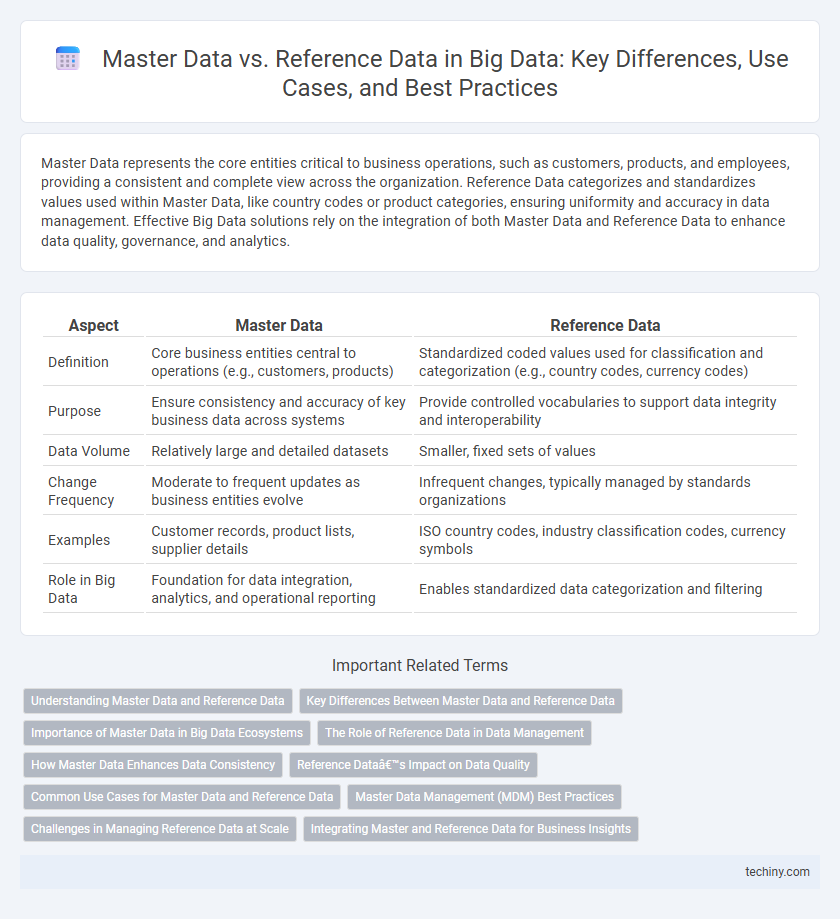Master Data represents the core entities critical to business operations, such as customers, products, and employees, providing a consistent and complete view across the organization. Reference Data categorizes and standardizes values used within Master Data, like country codes or product categories, ensuring uniformity and accuracy in data management. Effective Big Data solutions rely on the integration of both Master Data and Reference Data to enhance data quality, governance, and analytics.
Table of Comparison
| Aspect | Master Data | Reference Data |
|---|---|---|
| Definition | Core business entities central to operations (e.g., customers, products) | Standardized coded values used for classification and categorization (e.g., country codes, currency codes) |
| Purpose | Ensure consistency and accuracy of key business data across systems | Provide controlled vocabularies to support data integrity and interoperability |
| Data Volume | Relatively large and detailed datasets | Smaller, fixed sets of values |
| Change Frequency | Moderate to frequent updates as business entities evolve | Infrequent changes, typically managed by standards organizations |
| Examples | Customer records, product lists, supplier details | ISO country codes, industry classification codes, currency symbols |
| Role in Big Data | Foundation for data integration, analytics, and operational reporting | Enables standardized data categorization and filtering |
Understanding Master Data and Reference Data
Master Data represents the core entities critical to business operations, such as customers, products, and suppliers, serving as a single source of truth across systems. Reference Data consists of standardized lists and codes like country codes, currency codes, and industry classifications that provide consistent context and categorization. Understanding the distinction enables effective data governance and improves data quality in big data environments.
Key Differences Between Master Data and Reference Data
Master Data represents critical business entities, such as customers, products, and employees, that are central to an organization's operations and require consistent management. Reference Data consists of standardized codes or classifications, like country codes or currency types, used to categorize and validate transactional data across systems. Key differences include Master Data's focus on core business objects with evolving attributes, while Reference Data provides fixed, authoritative values that support data integrity and interoperability.
Importance of Master Data in Big Data Ecosystems
Master data serves as the foundational dataset that defines key business entities such as customers, products, and suppliers, ensuring consistent and accurate information across Big Data ecosystems. Its critical role enables seamless data integration, improved analytics accuracy, and enhanced decision-making by providing a single source of truth. Effective master data management (MDM) mitigates data silos and redundancy, driving operational efficiency and governance in complex, large-scale data environments.
The Role of Reference Data in Data Management
Reference data plays a critical role in data management by providing standardized categories and classifications that ensure consistency across diverse data sets. It serves as a foundation for master data by defining the permissible values and helping maintain data integrity, facilitating accurate reporting and analysis. Effective management of reference data enables organizations to harmonize information from disparate sources, enhancing data quality and decision-making processes.
How Master Data Enhances Data Consistency
Master Data enhances data consistency by providing a single, authoritative source of core business entities such as customers, products, and suppliers, ensuring uniformity across various systems and applications. It eliminates discrepancies caused by duplicate or conflicting data entries, enabling accurate reporting and analytics. By maintaining consistent master data, organizations improve data quality, streamline business processes, and support reliable decision-making.
Reference Data’s Impact on Data Quality
Reference data plays a crucial role in enhancing data quality by providing consistent, standardized values that ensure accuracy and reliability across big data systems. It serves as a benchmark for validating master data, reducing errors and inconsistencies in data integration and analysis processes. Effective management of reference data improves data governance, enabling more precise decision-making and compliance with regulatory standards.
Common Use Cases for Master Data and Reference Data
Master Data is commonly used to maintain consistent, accurate information about key business entities such as customers, products, and suppliers, enabling unified views across transactional systems. Reference Data supports standardization and categorization by providing fixed values like country codes, currencies, and industry classifications essential for data validation and reporting. Both data types are critical in Big Data environments for ensuring data quality, improving analytics precision, and driving operational efficiency.
Master Data Management (MDM) Best Practices
Master Data Management (MDM) best practices emphasize the clear distinction between master data, which encompasses core business entities like customers, products, and suppliers, and reference data, which provides contextual classifications such as country codes or currency types. Effective MDM involves creating a centralized master data repository, ensuring data accuracy through regular validation, and implementing robust governance policies to maintain data consistency across enterprise systems. Leveraging automated matching algorithms and establishing stewardship roles enhances data quality, driving reliable analytics and informed decision-making in big data environments.
Challenges in Managing Reference Data at Scale
Managing reference data at scale presents challenges such as ensuring data consistency, maintaining data quality, and handling frequent updates across distributed systems. The complexity increases with varied data sources, requiring robust governance frameworks and automated validation processes to synchronize reference values effectively. Inadequate management can lead to data discrepancies that impact analytics accuracy and operational efficiency in big data environments.
Integrating Master and Reference Data for Business Insights
Integrating master data and reference data enhances data consistency and accuracy across business systems, enabling more reliable analytics and decision-making. Master data, representing core business entities, combined with standardized reference data, supports comprehensive data governance and streamlined processes. This integration drives actionable business insights by providing a unified and enriched data foundation for advanced analytics and reporting.
Master Data vs Reference Data Infographic

 techiny.com
techiny.com